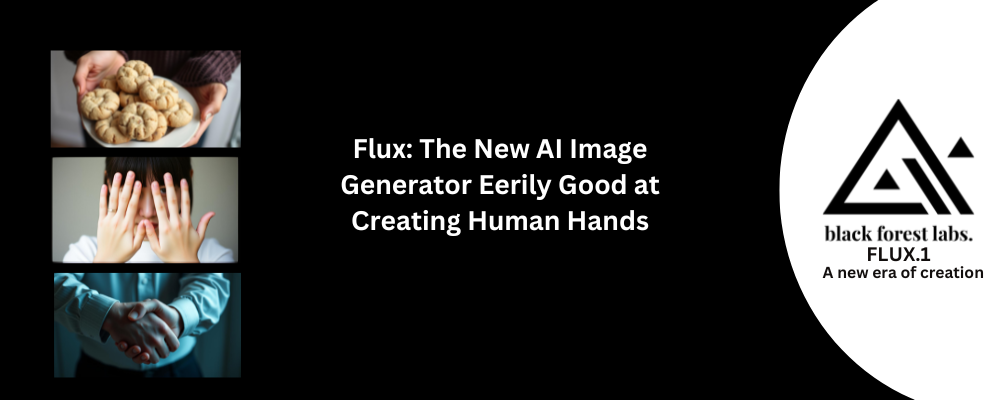In the ever-evolving world of artificial intelligence, the emergence of powerful tools like Flux AI Image Generator has redefined the boundaries of digital creativity. Among its remarkable capabilities, Flux has stunned the creative community with its exceptional proficiency in generating human hands, a challenge that has perplexed many AI systems until now. In this article, we’ll explore Flux’s capabilities, why it stands out, and what it means for the future of AI-generated art.
What is Flux?
Flux is a cutting-edge AI image generator that leverages advanced algorithms to create high-quality images from textual descriptions. Developed to push the limits of creative AI, Flux has quickly gained attention for its uncanny ability to render human hands with an unprecedented level of detail and accuracy.
You can try Flux by going to https://deforum.art/ and joining thier Discord Server
Why Human Hands are a Challenge for AI
Human hands are intricate structures with complex anatomy, subtle nuances, and varying poses that make them particularly difficult for AI to replicate accurately. For years, even the most advanced AI models have struggled to produce realistic representations of hands, often resulting in distorted or unnatural images. Flux, however, has managed to overcome these challenges, raising the bar for what AI can achieve.

Prompt: A close-up photo of a pair of hands holding a plate full of cookies
The Technology Behind Flux
1. Neural Networks and Deep Learning
At the core of Flux’s capabilities is its sophisticated neural network architecture. Using deep learning techniques, Flux analyzes vast datasets of images, learning the subtle patterns and structures that define human hands. This allows the AI to generate images that are not only realistic but also contextually appropriate.
2. Generative Adversarial Networks (GANs)
Flux employs Generative Adversarial Networks (GANs), a type of AI model that consists of two networks: a generator and a discriminator. The generator creates images, while the discriminator evaluates their realism. Through this process, Flux continually improves its ability to create convincing images of human hands.
3. Reinforcement Learning
Flux also utilizes reinforcement learning, a method where the AI learns from its mistakes and improves over time. This iterative process allows Flux to fine-tune its outputs, ensuring that the generated images meet the high standards of quality and accuracy expected by users.
Applications of Flux
1. Digital Art and Design
One of the most exciting applications of Flux is in digital art and design. Artists can use Flux to generate realistic human hands, saving time and effort while achieving results that would be challenging to create manually. This opens up new possibilities for creative expression and innovation.
2. Advertising and Marketing
In the advertising and marketing industries, Flux’s ability to produce high-quality images can be a game-changer. Whether it’s for product photography, promotional materials, or social media content, Flux can generate compelling visuals that captivate audiences and drive engagement.
3. Virtual Reality and Gaming
Flux’s realistic image generation capabilities are also valuable in the realms of virtual reality and gaming. Game developers can use Flux to create lifelike characters and environments, enhancing the immersive experience for players.
Ethical Considerations and Challenges
1. Copyright and Ownership
With the rise of AI-generated art, questions surrounding copyright and ownership have become increasingly relevant. Who owns the rights to an image created by an AI like Flux? This is a complex issue that legal systems around the world are grappling with, and it will require thoughtful consideration as AI technology continues to evolve.
2. Authenticity and Originality
Another challenge posed by AI-generated art is the question of authenticity. Can an image created by an AI be considered “original” in the same way that a piece of art created by a human is? This debate touches on the very nature of creativity and what it means to be an artist in the digital age.
3. Potential for Misuse
As with any powerful tool, there is the potential for misuse. AI-generated images could be used to create misleading or deceptive content, raising ethical concerns about the impact of such technology on society.
The Future of AI Image Generation
1. Continued Advancement
The field of AI image generation is rapidly advancing, and Flux is at the forefront of this progress. As the technology continues to improve, we can expect even more impressive and lifelike images to be produced by AI systems.
2. Integration with Other Technologies
Looking ahead, we may see AI image generators like Flux integrated with other technologies, such as augmented reality (AR) and mixed reality (MR). This could lead to new forms of interactive media that blur the lines between the virtual and physical worlds.
3. Impact on Creative Industries
AI tools like Flux are poised to have a significant impact on creative industries. While some may worry about the potential for AI to replace human artists, others see it as an opportunity to augment human creativity and open up new possibilities for artistic expression.
Conclusion
Flux represents a significant leap forward in the capabilities of AI image generators, particularly in its ability to create realistic human hands. This achievement not only demonstrates the power of AI in creative fields but also raises important questions about the future of art and technology. As we continue to explore the potential of AI, tools like Flux will undoubtedly play a crucial role in shaping the future of digital creativity.
FAQs
1. What makes Flux different from other AI image generators?
Flux stands out due to its exceptional ability to create realistic human hands, a task that has historically been challenging for AI systems.
2. Can Flux be used by non-professionals?
Yes, Flux is designed to be user-friendly and accessible to both professionals and hobbyists.
3. Is AI-generated art copyrightable?
The question of copyright for AI-generated art is complex and varies by jurisdiction, with ongoing debates about who owns the rights to such works.
4. How does Flux handle the ethical concerns related to AI-generated content?
Flux incorporates ethical guidelines in its development, but the responsibility for ethical use ultimately lies with the users of the technology.
5. What are the potential future developments for Flux?
Future developments may include integration with AR and MR technologies, as well as continued improvements in image realism and versatility.




